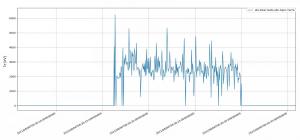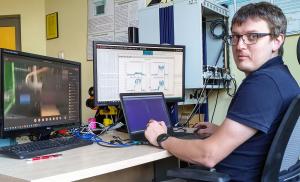Diagnosing the plasma in real time
To do its job well, ITER's plasma control system will need reliable real-time measurements from diagnostic systems. Engineers from the Controls Division have developed a high-performance software base, called a real-time framework, that can facilitate the development and deployment of complex real-time applications such as these. Recent tests on a Thomson scattering diagnostic on the KSTAR tokamak in Korea show that the framework functions successfully in real-world applications.
The design, development and verification of real-time software is a complex and often lengthy process requiring multiple iterations until all timing relationships are satisfied and the application is stable and predictable. "This complexity is why the ITER CODAC group has chosen to design and develop a dedicated real-time framework (RTF)," says Control Systems Integration Engineer Woong-Ryol Lee. "The RTF is a flexible high-performance software base that facilitates the development and deployment of complex real-time applications. Originally developed with the aim of control algorithms, the RTF can also be the basis for real-time data processing applications in ITER diagnostic systems."
In the first practical application of the framework, the Department of Microelectronics and Computer Science of the Lodz University of Technology (Poland)—in cooperation with the ITER CODAC group—has developed a RTF-based prototype system for Thomson scattering diagnostics data acquisition and processing. The system, readied by Dariusz Makowski, allows for acquiring data from a gigasample digitizer, processing real-time algorithms, archiving raw data using the ITER Data Archiving Network, and publishing measurements to the ITER Synchronous Data Network. The algorithms implemented in the system includes detection and integration of pulses in raw data from a Thomson scattering polychromator, noise estimation, and the calculation of plasma electron temperature.
Early August, it was time to see the system in action. Thanks to the hospitality of the team responsible for Thomson scattering diagnostics at the KSTAR tokamak, the prototype RTF-based system was installed and configured, enabling functional and performance tests under real working conditions. The tests were important not only for the evaluation of the prototype Thomson scattering system itself, but also for the functionality and performance of the RTF and the developed algorithms. It was the first evaluation of a high-performance data processing application implemented using RTF for the needs of plasma diagnostics.
The results obtained confirmed that RTF performs as expected, and that it can be used successfully in applications requiring multi-threaded high-performance data processing. "The prototype Thomson scattering system using the RTF was able to process data and provide final measurements within 5-6 ms, which is fully enough for a system working with a 20-50 Hz repetition rate," says Lee. "Moreover, the RTF hides many details specific to real-time systems (e.g., thread management, inter-thread data transfers, etc.), making the design and development of real-time software much easier and faster. The developed prototype—covering complete data acquisition, the processing path, archiving, as well as measurement publishing—can be used as a reference example for other ITER diagnostic systems."
Due to the limitations associated with the COVID-19 pandemic, the tests were performed remotely. The KSTAR team was responsible for hardware and on-site actions, while the team from Lodz and ITER staff operated the system remotely.
"This was also a great opportunity to invite young students from all institutions involved in the tests to attend the two days of the testing campaign," says Lee. "By sharing the experience with students who are at the beginning of their professional careers, and giving them the opportunity to observe science in action, we hope to encourage them to become valuable members of the fusion community."
Participants in this "real-time" success include Woong-Ryol Lee, Anze Zagar, Stefan Simrock, and Mikyung Park of the ITER Organization; Piotr Perek, Milosz Kadziela, and Dariusz Makowski from the Department of Microelectronics and Computer Science of the Lodz University of Technology; and Jong-Ha Lee, Ha-Jin Kim and Seung-Ju Lee from KSTAR.



